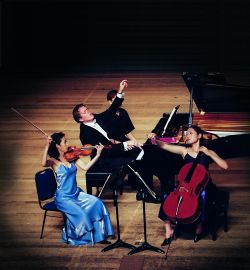|
Symphony
SRS SEASON ENDS WITH RESOUNDING TA-TA-TA-BANG
by Terry McNeill
Sunday, June 1, 2025
Symphony
YOUTHFUL VIRTUOSITY ON DISPLAY AT USO'S MAY CONCERTS
by Peter Lert
Saturday, May 17, 2025
Symphony
MYSTICAL PLANETS AND LIVELY GERSHWIN ORTIZ AT FINAL SRS CONCERT
by Peter Lert
Sunday, May 4, 2025
Symphony
VSO'S CONCERT MUSIC OF TIME, MUSIC OF PLACE
by Peter Lert
Sunday, April 27, 2025
Choral and Vocal
VOCAL ELEGANCE AND FIRE AT THE 222'S RECITAL APRIL 26
by Pamela Hicks Gailey
Saturday, April 26, 2025
CANTIAMO SONOMA SINGS AN INSPIRED GOOD FRIDAY MOZART REQUIEM CONCERT
by Pamela Hicks Gailey
Friday, April 18, 2025
DRAMATIC SHOSTAKOVICH SYMPHONY CLOSES PHILHARMONIC'S 25TH SEASON
by Terry McNeill
Sunday, April 13, 2025
LARGE COLLEGE OF MARIN AUDIENCE GREETS STOPHER ARTISTRY
by Terry McNeill
Saturday, April 5, 2025
Chamber
FRISSON DELIVERS SHIVERS OF DELIGHT
by Abby Wasserman
Sunday, March 30, 2025
OLD AND MOSTLY NEW IN SRS MARCH CONCERT IN WEILL
by Peter Lert
Saturday, March 22, 2025
|
 |
 Trio Con Brio |
SOMETHING AWESOME FROM THE STATE OF DENMARK
by David Parsons
Friday, February 20, 2009
The Trio con Brio Copenhagen returned to the SRJC Chamber Concerts Series Feb. 20 in a program devoted to two massive piano trios, prefaced with an anniversary cello/piano duo.
Although Mendelssohn’s Song without Words, Opus 109, was chosen to open the program in honor of the composer’s 200th anniversary this year, this tender love poem is worth including anytime. Korean cellist Soo-Kyung Hong, with her Danish husband pianist Jens Elvekjaer, made an eloquent statement in the tranquil first and last sections of the piece, creating a mood shaken only by the more emotional middle section. The long silent pause just before the return of the theme in the third section was breathtaking in its poignant intensity. Mendelssohn composed all too little music for solo cello, and it is a joy to hear what there is, especially in the medium of the nearly “vocal” singing of the cello. The Trio con Brio included this piece in their Mendelssohn bicentennial program at the Library of Congress just two days before this concert.
For the remainder of the ambitious program, the duo became a trio as Ms. Hong’s sister, violinist Soo-Jin Hong, joined the group for Beethoven’s famous “Archduke” Trio, Op. 97. The composer’s deafness by that time was far enough advanced that he could not really play accurately in ensemble, with predictably unsatisfactory results. Nonetheless, a room in the historic Hotel zum Römischer Kaiser in Vienna (formerly a small palace) had been hired, and two of Beethoven’s friends joined him to play. The lengthy work was dedicated to Archduke Rudolph, youngest son of Emperor Leopold II and brother of the then-current Emperor Franz. Beethoven dedicated the G Major and E-Flat Major Piano Concertos to Rudolph, as well as three piano sonatas, a violin sonata, the Missa Solemnis and the Grosse Fuge.
Although Beethoven typically grows loud and rough in the development sections of movements, he often starts first movements quietly, and marked this score dolce. This opening gives an elevated air to the movement. Elvekjaer had a delicate touch and used the shift pedal judiciously to underscore the ensemble. One of the moments when the piano line was balanced and sufficiently pianissimo to accommodate the softness of the strings occurred during the first movement, where Beethoven may have been trying to shock convention with his extended use of pizzicato in the strings. The typical Classical four-movement structure, where a slow movement usually comes second and a lighter minuet or scherzo third, is changed in the B-Flat Trio. A jocular Scherzo follows the opening Allegro, although its liveliness yields to some mysterious creepy chromatic contrapuntal imitation prior to the ending.
The slow movement, a set of five variations on a serene, hymn-like melody, is the work’s spiritual centerpiece. The string players’ most eloquent touch here was on the last notes of the expressive coda, when they played without vibrato, reinforcing the calm with stunning effect. The Rondo finale bursts forth with typical Beethovenian humor.
All in all, the Archduke Trio marks the summit of Beethoven’s production for that medium, and it is among his greatest chamber-music masterpieces, here superbly played and warmly applauded. To hear it followed with the rarely-performed Dvořák Piano Trio in F Minor, possibly the greatest piano trio from the second half of the 19th century, made this an extraordinarily rich program of music.
What struck me throughout the Dvořák was the perfect structure of the movements, the gorgeous melodies pouring forth one after the other, clearly and logically developed and leading to convincing conclusions. The secondary theme of the first movement is my favorite, reminding me of a homecoming after a long time away. The ensemble handled the rhythmic ambiguities of the Scherzo second movement adroitly. The intimate interactions of the players, listening to and watching each other for timing and balance, were a demonstration of virtuoso chamber music playing. The tension built up in the minor-keyed last movement, finally resolving to the major, gave a thrillingly satisfying sense of achievement and relief. The last movement is marked con brio, and the Trio con Brio more than lived up to the instruction and their own ensemble’s name.
The rapt audience was rewarded with an encore: Haydn’s familiar Gypsy Rondo. Here there were lively reminiscences of the gypsy folk music Haydn heard during his years of working at the Esterhazy estate and in Hungary.
|

